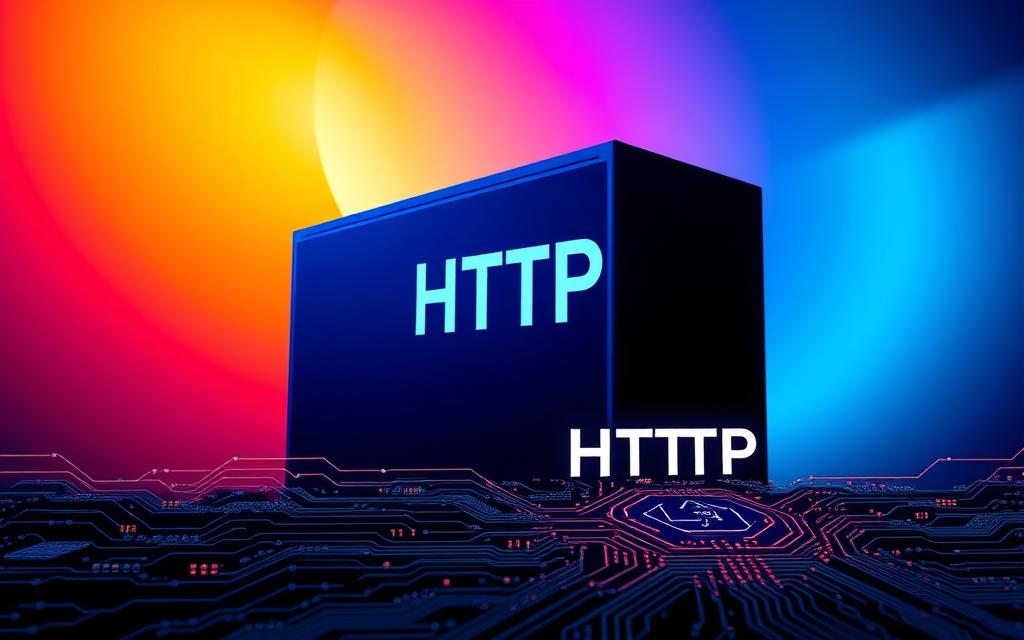HTTP is the vital system that powers internet communication. It allows data to flow smoothly between web browsers and servers worldwide1.
Since its birth in the early 1990s, HTTP has grown impressively. It began by handling simple HTML documents. Now, it manages complex web resources with ease2.
Today, HTTP is the lifeblood of the internet. Around 1.8 billion websites use this crucial protocol for online interactions1.
HTTP has seen many updates over time. Each new version, from HTTP/0.9 to HTTP/3, has boosted speed and efficiency2.
Mobile devices now generate over half of all web traffic. This shift highlights the need for fast, responsive HTTP protocols1.
What is HTTP in Computer Networks?
HTTP is a vital communication protocol for web interactions across global computer networks. It connects clients and servers, enabling seamless data transfer on the internet3.
https://www.youtube.com/watch?v=r4VY6K3jo5s
Tim Berners-Lee developed HTTP between 1989 and 1991, revolutionising digital communication3. The protocol has evolved through multiple versions to meet changing network demands.
Understanding the Client-Server Model
The client-server model forms the core of HTTP architecture. Web browsers act as clients, sending requests to web servers.
Servers process these requests and return specific resources. This interaction allows users to access diverse online content4.
Key Features of HTTP Protocol
- Stateless communication, where each request is independent
- Text-based protocol allowing human-readable messages
- Supports multiple data transfer methods
HTTP operates as a stateless protocol, processing each request independently. To maintain session context, technologies like HTTP cookies enable stateful experiences4.
Evolution from HTTP/1.0 to HTTP/3
The protocol evolution shows remarkable technological progress. Each version from HTTP/1.0 to HTTP/3 brought significant improvements:
- HTTP/1.1: Introduced persistent connections4
- HTTP/2: Enabled multiplexing and header compression4
- HTTP/3: Published in 2021, offering enhanced performance3
Modern HTTP versions focus on efficiency and speed. They reduce latency and improve overall web interaction speeds3.
The HTTP Request-Response Cycle
Web communication relies on a sophisticated dance between clients and servers. HTTP serves as the universal language of internet interactions5. This process enables seamless data exchange across digital platforms.
The HTTP protocol defines rules for information exchange. It ensures clients and servers communicate effectively5. The cycle involves HTTP requests sent by clients and responses returned by servers.
Components of HTTP Requests
HTTP requests are structured communications that inform servers about desired actions. They typically include several crucial elements:
- Request method (verb)
- Uniform Resource Identifier (URI)
- Headers
- Optional message body
Five common HTTP verbs drive these requests: GET, POST, PUT, PATCH, and DELETE. These correspond to fundamental data manipulation operations5. Example paths might include:
- /tasks
- /tasks/4
- /items/6/reviews
Understanding HTTP Response Structure
Servers respond to requests with structured HTTP responses. Browsers can interpret and display these responses5. They contain critical information about the request’s processing.
Status Codes and Their Meanings
HTTP status codes provide immediate insight into request outcomes6. They range from 100 to 500. These codes are categorised into five distinct groups:
| Category | Range | Description |
|---|---|---|
| Informational | 100-199 | Initial response details |
| Success | 200-299 | Request successfully processed |
| Redirection | 300-399 | Additional action required |
| Client Errors | 400-499 | Issues with client request |
| Server Errors | 500-599 | Problems on server side |
Some notable status codes include6:
- 200 OK: Successful request
- 404 Not Found: Resource does not exist
- 500 Internal Server Error: Unexpected server condition
Understanding the HTTP request-response cycle is fundamental for web developers seeking to create robust, efficient digital experiences.
HTTP Methods and Their Applications
HTTP methods are key communication protocols for web servers. They define how servers handle different requests7. These methods enable precise interactions between clients and web servers8.
The five most commonly used HTTP methods in RESTful APIs include:
- GET: Retrieves data from a server, being the most frequently used method7
- POST: Submits data to be processed by the server, capable of sending various data formats7
- PUT: Completely replaces an existing resource on the server7
- DELETE: Removes a specified resource from the server7
- PATCH: Applies partial modifications to existing resources7
Each method plays a unique role in web communication. GET requests can be cached and bookmarked. POST requests aren’t cacheable but offer more secure data transmission8.
| HTTP Method | Primary Function | Characteristics |
|---|---|---|
| GET | Retrieve data | Cacheable, maximum 2048 characters |
| POST | Submit data | Not cacheable, supports binary data |
| PUT | Replace resource | Idempotent operation |
| DELETE | Remove resource | Permanently removes data |
Understanding and correctly implementing HTTP methods is crucial for developing robust and efficient web applications.
Proper use of HTTP methods is vital for web developers. It ensures secure, efficient, and semantically correct client-server interactions8.
Security and HTTPS Implementation
HTTPS is a vital protocol that safeguards data transmission online. It uses SSL/TLS encryption to secure communication between browsers and websites. This protection helps prevent cyber threats and boosts a site’s trustworthiness910.
Search engines now favour HTTPS websites due to their enhanced security features. This preference has led to widespread adoption of HTTPS across the internet910.
Digital certificates are crucial for web security authentication. Websites must obtain SSL/TLS certificates from trusted authorities to establish secure connections9. These certificates verify a website’s identity and enable encrypted data transmission.
Extended Validation (EV) certificates offer the highest level of verification. They are particularly important for e-commerce and financial platforms10.
HTTPS adoption has grown steadily, improving web security standards. As of December 2022, 58.4% of popular websites used secure HTTPS protocols11.
Modern browsers now warn users about unsecured connections. This practice encourages websites to prioritise encryption and protect sensitive user information11.
FAQ
What is HTTP and why is it important?
How does the client-server model work in HTTP?
What are the key differences between HTTP versions?
What are the most common HTTP methods?
Why is HTTPS important for web security?
What is an HTTP status code?
How do digital certificates work in web security?
What makes HTTP a stateless protocol?
What is the difference between HTTP and HTTPS?
How do HTTP methods relate to RESTful API design?
Source Links
- https://www.freecodecamp.org/news/http-full-course/
- https://medium.com/@MakeComputerScienceGreatAgain/a-deep-dive-into-http-the-backbone-of-the-world-wide-web-423bb0218a51
- https://www.techtarget.com/whatis/definition/HTTP-Hypertext-Transfer-Protocol
- https://developer.mozilla.org/en-US/docs/Web/HTTP/Overview
- https://backend.turing.edu/module2/lessons/how_the_web_works_http
- https://dev.to/marlinekhavele/http-requestresponse-cycle-mb6
- https://www.theserverside.com/blog/Coffee-Talk-Java-News-Stories-and-Opinions/HTTP-methods
- https://www.w3schools.com/tags/ref_httpmethods.asp
- https://aws.amazon.com/compare/the-difference-between-https-and-http/
- https://www.semrush.com/blog/http-vs-https/
- https://en.wikipedia.org/wiki/HTTPS












